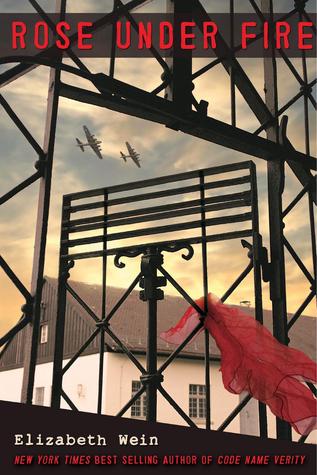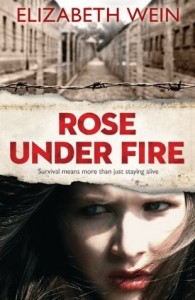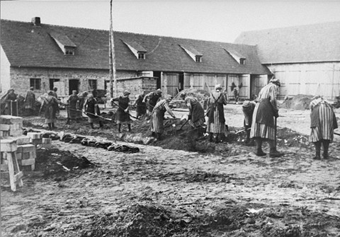Rose under fire by Elizabeth
Wein (Hyperion, 2013)
ISBN 978-142318309-9
360 pages
Subjects:
World War Two, France, Resistance, pilots, women in war, concentration camps,
Ravensbrück, Nuremburg, young adult fiction (Years 10-13)

Synopsis
It’s
August, 1944. Rose Moyer Justice, aged 18, from a Pennsylvania Dutch family in
the United States, has come to England to work for the British Air Transport
Auxiliary. Rose’s family is obviously wealthy and she learnt to fly at the age
of 12, so she is quite confident delivering planes to bases all over the
country.
Rose
is keen to fly to France as well, and gets permission to do so a few days after
Paris has been freed in September 1944 but her return flight goes wrong when
she is captured in the air by German planes and made to land at an airfield in
Germany. From there, she is taken to
Ravensbrück concentration camp where she is registered as a French political
prisoner, despite having an American passport.
Rose
makes friends at the camp, including Irina, a Russian pilot, and a young Polish girl
called Roza, one of the group known as Rabbits who have been used for
medical experiments by the Nazis. Everyone is treated badly in the camp, but
the women are determined that the story of the brutality meted out to the
Rabbits should reach the outside world. Rose, an aspiring poet, comforts
them with poems by her favourite writer, Edna St Vincent Millay, and also makes
up a poem to remember their names. She doesn’t let on that she has already
heard reports about their treatment on the wireless and dismissed them as
propaganda.
There is little let-up from the grim scenes at the camp,
which take up 200 of the 360 pages. The events and living conditions are not
dwelt on gratuitously, but
they are still stomach-churning if you stop to think of the implications or to
imagine the reality. Readers who only know of the camps from Anne Frank’s diary
– which stops, of course, before she arrives there – will find this a very
different, and possibly difficult reading experience.
The story of how Rose readjusts to outside life takes up the
last section of the book (which is where the Nuremburg Trials come into it.) In
some ways, this widens the scope of the book as it relates to how anyone who has
been through trauma comes to terms with it.

Reviews:
This review on Gossamer obsessions calls it "definitely a darker, bleaker novel than Verity." The review does raise the
point - which I was aware of as I read - that the diary nature of the book works
“for and against” it. Rose can’t keep a diary in Ravensbrück (or it would have
stretched credibility if she had been able to write one in sufficient detail
and smuggle it out as well) so that
portion of the story is written while she is staying in a hotel in Paris after
her release. But that means we realise she has escaped to safety, which takes away
some of the tension of the events described. The only (slight) tension left is
that we know something about her boyfriend, Nick, that she doesn’t yet know. Rose
has lost touch with her concentration camp friends, but we expect she will find
them again.
The Los Angeles times called the book "a soaring tale of triumph."
Author’s website
Elizabeth Wein has written books set in Arthurian Britain
and sixth century Ethiopia. Code name
Verity is about a female pilot who is captured in France; her story is mentioned
in Rose under fire, because the character of Maddie connects the two
pilots.
There is an interview with Elizabeth Wein here on the girls like giants blog.
And it’s
also interesting to note that she is a pilot herself.
From another
interview in the Vancouver Sun:
Q Why did you write this book?
A I think that the dark underbelly of women’s wartime roles is
fascinating. My previous novel, Code Name Verity, takes an inside look at the
dangerous and dirty work that women did as spies and saboteurs for resistance
movements in Nazi occupied Europe. Rose Under Fire more or less continues the
story of these women — about a third of those sent into occupied France ended
their lives as prisoners in concentration camps. I was particularly fascinated
with Ravensbrück because it was a camp specifically for women. It was operated differently
from other camps; its history is not well known and is worth knowing.
Other books you might like:
There must be
very few books written about women in concentration camps, compared to the large
number of books about men in that situation. The books that spring to mind are escape
stories, like The great escape, so they are more “heroic” in nature, and
perhaps it was simply impossible for women to even try to escape – how would
they have survived outside?
NZ connections:
You can
read my review of Code name Verity for more details about the Air Transport
Auxiliary, including a brief profile of Jane Winstone, one of the few NZers in
the ATA.
Things I didn’t know
It’s a side issue, but I didn’t know that the emigrants who settled in Pennsylvania Dutch
Country in the USA (incl the Amish) weren’t named because they were Dutch, but
because of the dialect of the language they spoke. They came from a number of
German-speaking areas in Europe, such as Alsace in France, Switzerland and
Germany. This adds an extra layer of
irony of the story, in that Rose is being held captive in the land where her
family came from.
If you want to, you can read more about the Nuremburg Trial or the Polish Rabbits, but some of this material is confronting.
Ravensbrück is now a museum. More than
132,000 women and children from twenty-three countries passed through this
concentration camp…At least 92,000 of them perished. They were gassed, shot,
beaten and starved to death; or they died from sadistic medical experiments or
exposure or disease or exhaustion, or just because they gave up trying to
survive.
A low stone wall newly built by the lakeside bears a chiseled inscription in German by the East German writer Anna Seghers. It reads: “The women of Ravensbrück are the mothers and sisters of us all. You would not have been able to learn and play in liberty—indeed you might even not have been born—if women like these had not placed their delicate, weak bodies as a steel shield before you and your future.”
A low stone wall newly built by the lakeside bears a chiseled inscription in German by the East German writer Anna Seghers. It reads: “The women of Ravensbrück are the mothers and sisters of us all. You would not have been able to learn and play in liberty—indeed you might even not have been born—if women like these had not placed their delicate, weak bodies as a steel shield before you and your future.”
 |
| A work team in Ravensbrück |
![[IMG]](http://www.tab1.de/gfx/arrse/ravensbrueck12.jpg)
One of those who died Ravensbrück was Violette Szabo, the legendary SOE special agent. There is a poignant story about her training when she was trying to commit a poem to memory (this was a device to help code messages, using words from the poem. ) It was best not to choose well known poems in case the enemy could recognise them, and it was important to get the words and the spelling of the chosen poem exactly right. Violette kept making mistakes until the SOE codemaster, Leo Marks, gave her a new poem to learn. It was simple but memorable and it worked for Violette. Leo Marks had written the poem himself after the woman he loved had been killed in a plane crash.
The life that I have
Is all that I have
And the life that I have
Is yours
The love that I have
Of the life that I have
Is yours and yours and yours
A sleep I shall have
A rest I shall have
Yet death will be but a pause
For the peace of my years
In the long green grass
Will be yours and yours
And yours
Is all that I have
And the life that I have
Is yours
The love that I have
Of the life that I have
Is yours and yours and yours
A sleep I shall have
A rest I shall have
Yet death will be but a pause
For the peace of my years
In the long green grass
Will be yours and yours
And yours

